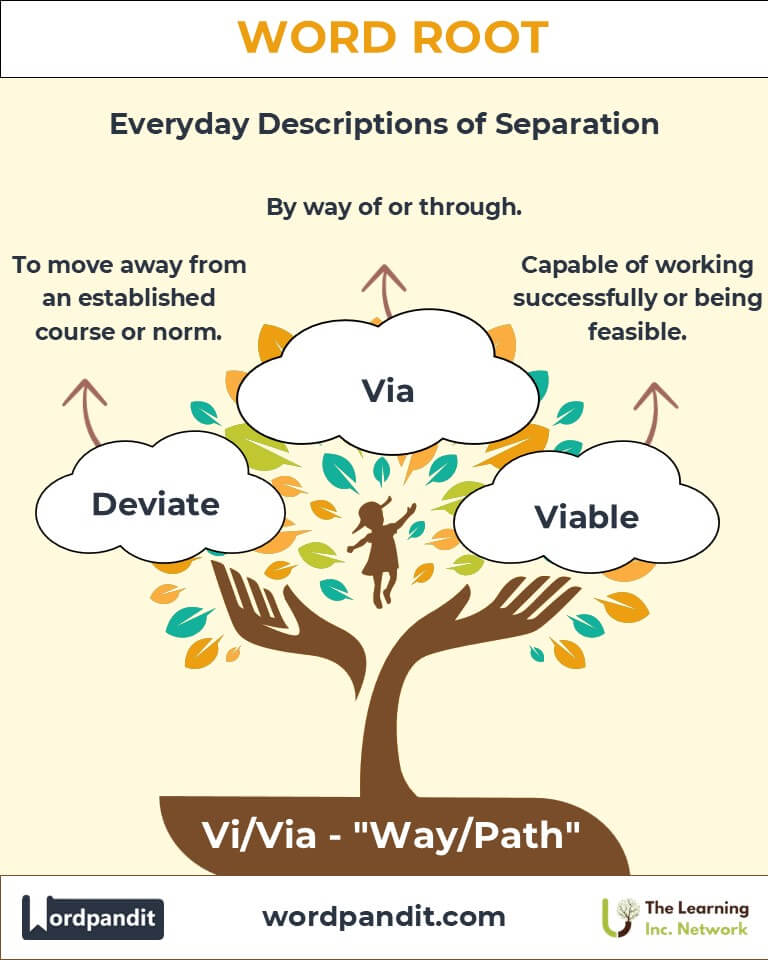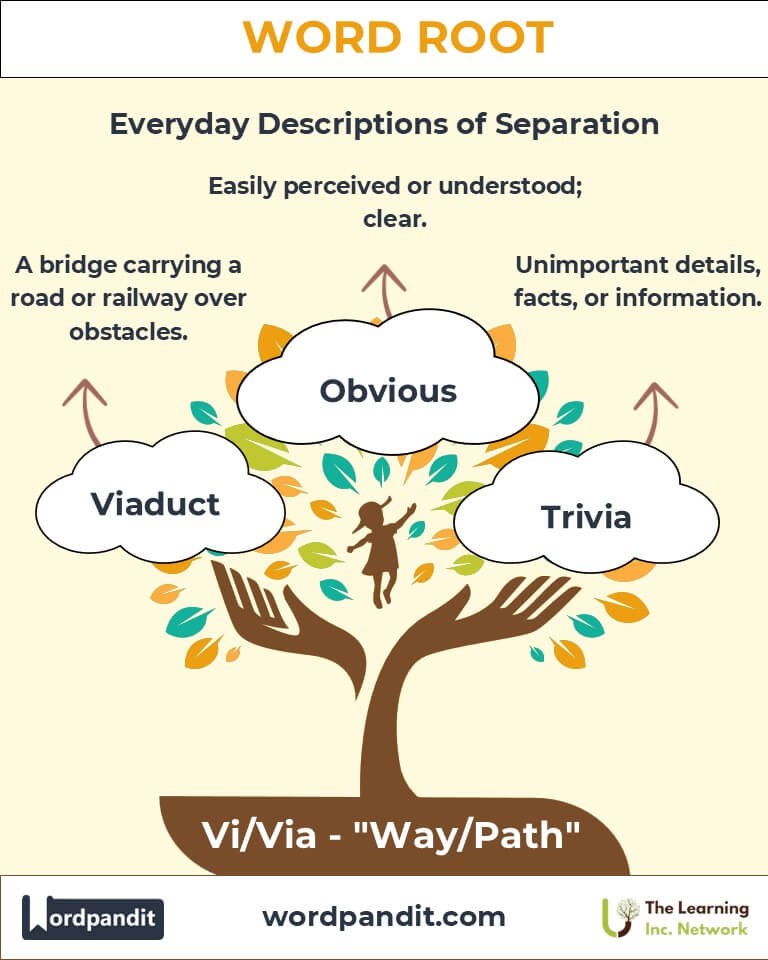Vi/Via: The Pathway to Progress in Language and Meaning
Byline: Explore the versatile Latin root "vi/via," meaning "way" or "path," and its profound impact on language. From practical terms like "viable" to transformative concepts like "deviate," this root defines how we navigate life's myriad routes and decisions.

Table of Contents
- Introduction: The Essence of Vi/Via
- Etymology and Historical Journey
- Mnemonic: Unlocking the Power of Vi/Via
- Common Vi/Via-Related Terms
- Vi/Via Through Time
- Vi/Via in Specialized Fields
- Illustrative Story: Vi/Via in Action
- Cultural Significance of Vi/Via
- The Vi/Via Family Tree
- FAQs About the Vi/Via Word Root
- Test Your Knowledge: Vi/Via Word Root Quiz
- Conclusion: The Living Legacy of Vi/Via
Introduction: The Essence of Vi/Via
When you think of "viable solutions" or how a person "deviates" from the norm, you’re engaging with the root "vi/via." Originating from Latin, this root embodies the idea of a "way," "path," or "road." Its applications extend from physical pathways to metaphorical routes in decision-making and progress.

Etymology and Historical Journey
The root "vi/via" derives from the Latin word via, meaning "way" or "road." Ancient Rome's vast road networks, called viae, symbolized connectivity and progress, influencing the development of words that denote direction, feasibility, and divergence. As the Roman Empire spread, so did its language, embedding "vi/via" into numerous European languages and eventually English.
Mnemonic: Unlocking the Power of Vi/Via
Picture a crossroads with a signpost pointing to various destinations: "viable options" in one direction and "deviation ahead" in another. This imagery helps associate "vi/via" with paths, choices, and possibilities.
Mnemonic Device: "Vi/Via shows the way: viable for the future, deviation for the brave."
Common Vi/Via-Related Terms
- Viable (vy-uh-bul): Capable of working successfully or being feasible.
Example: "The company developed a viable business plan for sustainable growth." - Deviate (dee-vee-ate): To move away from an established course or norm.
Example: "She chose to deviate from the traditional career path to follow her passion." - Via (vy-uh): By way of or through.
Example: "We traveled to the city via the scenic mountain route." - Obvious (ob-vee-us): Easily perceived or understood; clear.
Example: "The solution was so obvious that everyone overlooked it." - Trivia (tri-vee-uh): Unimportant details, facts, or information.
Example: "He has a knack for remembering trivia from classic movies."
Vi/Via Through Time
- Via: In ancient Rome, "via" described physical roads connecting cities. Today, it signifies metaphorical routes, like "via email."
- Deviate: Originally denoting a literal departure from a path, it now also describes metaphorical divergence, such as unconventional behavior.
Vi/Via in Specialized Fields
- Medicine: Viable refers to living tissue or cells capable of sustaining life.
Example: "The transplant was successful due to the viable donor organ." - Technology: Via denotes pathways in circuitry or data transmission.
Example: "The message was sent via encrypted channels." - Urban Planning: Viaduct: A bridge carrying a road or railway over obstacles.
Example: "The viaduct eased traffic congestion by connecting two busy highways."
Illustrative Story: Vi/Via in Action
Elena stood at a literal and metaphorical crossroads. Her team had presented a viable plan to expand their eco-friendly product line, but she felt the urge to deviate and explore uncharted ideas. Inspired by the Roman roads’ legacy of innovation and connectivity, she decided to combine the tried-and-true path with bold deviations, leading to a groundbreaking project that revolutionized her industry.
Cultural Significance of Vi/Via
The concept of "via" is deeply embedded in cultural expressions. From the philosophical notion of finding one’s path to practical applications like "via media" (the middle way), this root symbolizes both exploration and balance. Roman roads not only facilitated trade but also spread ideas, shaping Western civilization.

The Vi/Via Family Tree
- Ven/Vent (Come):
Examples: Advent (the arrival of something notable), Event (an occurrence). - Port (Carry):
Examples: Transport (to carry across), Import (to bring in). - Curr/Curs (Run):
Examples: Current (flowing or running), Cursor (a movable indicator).

FAQs About " Vi / Via "
Q: What do the roots "vi" and "via" mean?
A: The roots "vi" and "via" come from Latin, meaning "way" or "road." They form the basis of many words related to paths, journeys, and methods, such as "viable" (capable of living or working) and "via" (by way of).
Q: How does "viable" relate to "vi"?
A: "Viable" means capable of working or living successfully. It is derived from "vi," emphasizing a "way" or "means" to continue or succeed. For example, a viable plan is one that can realistically be executed.
Q: What is the origin of "deviate"?
A: "Deviate" comes from the Latin "deviare," where "de-" means "off" or "away" and "via" means "way." It refers to straying from a path, standard, or norm.
Q: What does "obvious" literally mean?
A: "Obvious" comes from the Latin "obvius," where "ob-" means "against" or "in front of" and "via" means "way." Literally, it means "standing in the way" or "clearly in view," which evolved to signify something easily seen or understood.
Q: Why is "via" used in routing or travel?
A: "Via" directly translates to "way" or "road" in Latin, making it ideal for describing the route taken to reach a destination. For instance, traveling "via" a specific city highlights the path chosen for the journey.
Test Your Knowledge: "Vi / Via " Mastery Quiz
1. What do "vi" and "via" mean?
2. Which word means "to stray from a path"?
3. What does "obvious" signify?
4. What does "viable" describe?
5. Why is "via" used in travel directions?
Conclusion: The Living Legacy of Vi/Via
The root "vi/via" continues to guide our language and thinking, reminding us of the importance of paths—literal, intellectual, and emotional. From the ancient Roman roads to today’s digital highways, it exemplifies humanity’s enduring quest to explore, connect, and progress. Let "vi/via" inspire you to find your way, whether by following a viable path or daring to deviate.












